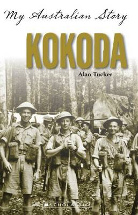Kokoda by Alan Tucker

My Australian story. Scholastic, 2014. ISBN 9781743622056.
Recommended for 12 years and above. The 39th Battalion which faced
the Japanese on New Guinea's Kokoda Track in 1942 were militia,
meaning that they were civilian reservists, rather than regular
army. Poorly trained, ill equipped and under resourced, they were
disparagingly referred to as 'Chocolate soldiers' (due to the colour
of their uniforms) and were considered to be second rate.
The amazing courage and endurance displayed by these soldiers who
not only survived intolerable conditions but effectively resisted
the previously invincible Japanese army has earned them a special
place in Australian military history.
With the use of letters, diary entries and chronological narration,
Alan Tucker explains the background events and details to readers
who might be unfamiliar with the legend. Three brothers are
characters involved in masterful storytelling which presents an
authentic and plausible family drama. Oldest brother Harold is
serving with the A.I.F. in the Middle East whilst middle brother Des
has joined the Militia which was destined to be the first to face
the advancing Japanese at Kokoda. Archie, the youngest, suffers from
a stutter and has always been protected by Des but has to grow up
and fend for himself against a bully which imitates what is
happening in the political and geographical theatre of war.
The author employs realistic techniques to progress the story. Des's
reportage of events on the track could not have taken place via
letter as this was impossible under the appalling circumstances but
infrequency and military censorship would have prevented it anyway.
Instead, a blood stained, smeared diary in jaded script finds its
way to Archie who has been charged with recording the family's
wartime experiences. History shows that Prime Minister Curtin did
demand the return of the A.I.F. troops from Syria to help defend
Australia and the reader accepts that Harold and his cohort come to
reinforce Des and his mates on the track. The wounded, exhausted and
traumatised survivors from the 39th really did turn around after
being relieved by the A.I.F. to go back up the track to support the
reinforcements who were facing overwhelming attackers. These details
are well known to older generations but this novel recounts history
to younger readers in a way which reads like a work of fiction, but
it's not, it's true. This book would have great value for studying
literature and history strands simultaneously and I greatly respect
the author for weaving an engaging but educational story with such
care and attention to facts whilst avoiding glamorising conflict.
Rob Welsh